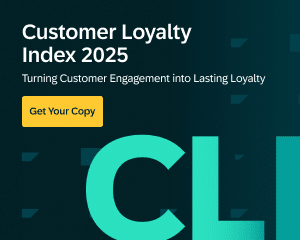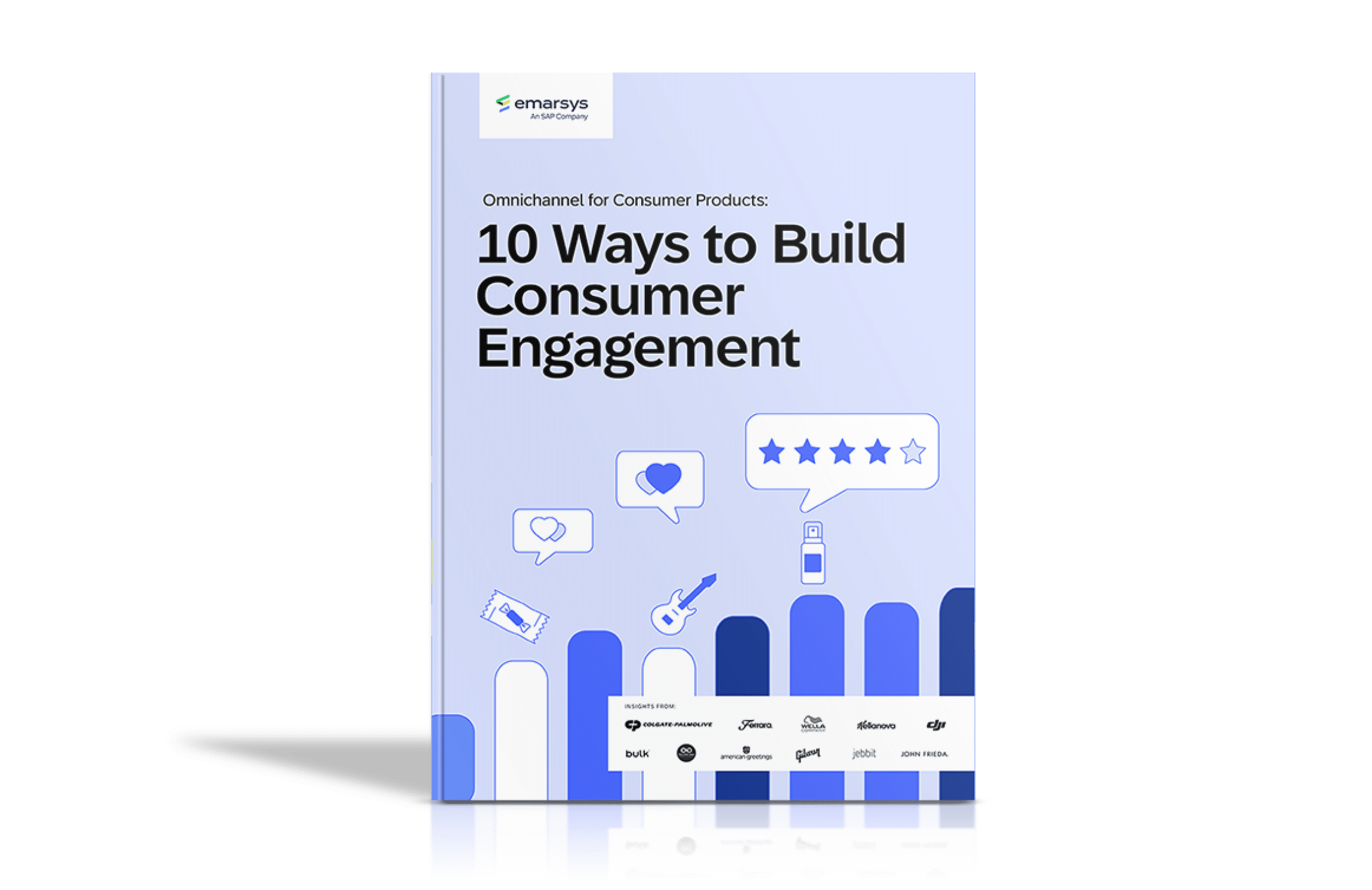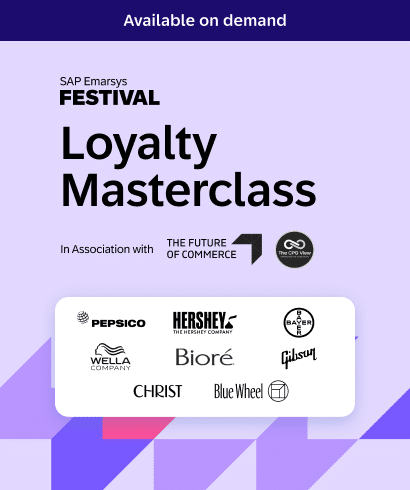The consumer products (CP) industry is facing ongoing disruption with rising consumer expectations, unreliable supply chains, and economic uncertainty, just to name a few hard truths.
To explore these challenges and, importantly, how CP marketers can take action to create direct consumer engagement, we reached out to experts at SAP to get their insights.

|
Robert Rabe is the Head of Product for Consumer Industries (Consumer Products, Fashion, Retail, Wholesale), and he’s been with SAP since 2011. He brings an end-to-end industry perspective to the development of SAP solutions. |
| Patrick Flohr is the End-to-End Product Manager for Consumer Products at SAP and joined SAP in 1991. His long history with SAP has given him a remarkable depth of understanding about the SAP product and how it serves the needs of consumer industries. | 
|
In this interview, we asked Robert and Patrick probing questions about the disruptors that are shaking up the world of CP marketing, as well as what marketers can do to overcome those challenges. Don’t miss the list of the top 5 hottest takeaways!
Consumer Products Industry Research Insights
Bain & Company found that 88% of consumer products companies are in the process of transitioning to S/4HANA, and 50% are deploying advanced digital marketing tools at scale. In your opinion, what’s driving this digital transformation?
Robert:
Transitioning to S/4HANA is a back-office play and digital transformation at the same time. Your CDP [customer data platform] gives you the customer data you need to create customer profiles. Then your customer engagement platform, like SAP Emarsys, enables you to connect with your customer. CDP gives you access to your customer data, and Emarsys allows you to send a personal message to customers to create an omnichannel experience. That experience happens on social, via text, in-store, and also via channels like retail media.
You also have to fulfill on that personalized message, and that’s where S/4HANA comes in, connecting the elements such as supply chain and inventory. You want to make sure that you’re not driving demand for something in a super personalized fashion only to find out you have a supply chain disruption that leaves customers frustrated.


Recommended Action:
Unify your front-end and back-end processes and data so you can deliver personalized messages and fulfill your brand promises.
The Global Consumer Products Engagement Report found that 76% of all consumer products marketers believe they must adapt to change “faster than ever before.” What is driving this pressure for rapid change, and what can CP brands do to become more adaptable?
Robert:
A few things are going on here. First, you have disrupted supply chains. You have more eco-conscientious consumers out in the market. You have a great deal of technology change coming, particularly with AI. All these factors are disrupting the brand-to-consumer relationship.
In the future, you’re not going to simply go to an e-commerce site and say, “I’m looking for this product.” Instead you’ll go to a site and say, “I’m throwing a birthday party. Here are my budget and theme. Give me a bill of materials for what I need.” Then that website will buy everything for you and ship it to your doorstep. AI agents will do that for you. This new disruption in the industry will force CPGs [consumer packaged goods] to build closer relationships with e-commerce sites and AI agents, because without that they won’t be able to keep up.
To build that relationship and deliver your product in this new buying landscape, you need to have the “boring stuff” together. By “boring stuff,” I mean all your data, your supply chain, how you’re interacting with customers, and so on. You have to connect your back office to your front office and have this in one place.
The SAP Business Data Cloud does exactly that for brands, bringing all your company’s touchpoints together, including supply chain, inventory, customer interaction perspective, and the finance perspective. We unify them in one system so you can have one view of your entire business. Then in the affiliated applications on top of that, such as your customer engagement platform, you can make informed decisions as opposed to making decisions in a silo. It’s all about integrated decision-making.
Recommended Action:
After unifying your systems and bringing your touchpoints together, use the insights you can to make informed decisions that will drive powerful, personalized engagement.
The same global CP report found that 63% of Gen Z worldwide say they don’t care about “brands” as long as a product meets their needs — more than any other generation. How is this “brand blindness” impacting CP brands?
Robert:
The way CPG brands have historically commanded higher premiums than white label brands is through the brand promise and the value they convey. With loyalty declining, we risk effectively commoditizing CPG brands at large. What marketers can do about this is implement strategies that directly engage consumers, like loyalty programs, which are becoming much more important from a CPG perspective.
If you’re entering retail directly as a CP brand, such as if you’re in fashion or other hard goods, it’s becoming much more important to enter stores on your own, to be present on social commerce, and to have your own e-commerce platform to engage directly with the consumers. Retail media is also very important because you as a brand can really go to the point of sale where customers engage in case you don’t have any other direct interaction points with customers.
Recommended Action:
To foster loyalty, implement strategies for direct consumer engagement, such as loyalty programs.
Omnichannel Marketing for Consumer Products
Traditionally CP brands have used limited channels, commonly email alongside one or two others, but we’re seeing that change. What’s the driver behind incorporating more channels into the mix?
Patrick:
It started in the COVID pandemic. That was when CP manufacturers recognized that they were very limited in their communication and sales channels. They recognized that retail is much farther ahead because the retail industry has more direct interaction with consumers. This connection allowed retail companies to directly address consumers across channels. Marketers could recommend products to consumers who were stuck in their homes, and consumers could use retail marketplaces to make purchases without going to a store.
CPG manufacturers realized they needed that direct connection as well, so they started email campaigns to address consumers. They started awareness campaigns in social media, like Instagram and Facebook. Manufacturers also started to build logistics. This was when we saw this movement by CPG brands toward expanding their channel usage.
Robert:
Something we’ve seen in North America and Asia, which isn’t possible in Europe because of GDPR, is this notion of interacting with customers via text or WhatsApp, which is a solution that Emarsys includes in its product portfolio. Brands can also use geofencing for this. Say you go on a road trip and you enter a new zip code or region. Based on where you are and if that information is shared — sometimes shared via telcos or via the brand app or loyalty program — based on that data, marketers can deliver targeted campaigns relevant to that zip code, which makes the message more relevant and powerful.
You can fence this in a really specific fashion and say, “I only want to target Customer A when they’re at home, or I only want to target Customer B when they are in a recreational area.” That overlay of personal information enables marketers to deliver a highly targeted offer that can also be executed via instant messenger, so the experience is delivered in the moment when it’s relevant.
Recommended Action:
Find creative ways to build direct connection with consumers across channels, including web, mobile, and social, within limits of proper customer consent and privacy regulations.
What does omnichannel mean to the average CP marketer?
Patrick:
Omnichannel opens new communication and data channels. The traditional CP manufacturer used to just use direct data received from the retailer, or perhaps they ran their own web shop and used it primarily for marketing activities. Today the CP manufacturers see the benefit of running their own web shops or selling directly via the marketplaces because they’re coming much closer to the consumers, getting a better understanding of which products they’re buying. They get direct feedback and build communities on their websites to gather that feedback, and with that they can improve and optimize both their products and their personalized marketing.
Robert:
What‘s enabling all of this, not just for the big players but also the smaller players, is third-party logistics providers. If a CPG brand from 20 years ago wanted to run its own web store, they’d have to do everything, such as managing supply chain, spinning up distribution, etc. Now even smaller CPGs can ship their stock to a third-party logistics provider or large marketplace, which handles everything for them. The benefit to the brand is understanding who is buying their products, which solves one of the key issues that CPGs have had for the longest time, which is, “Who is my customer, and how are they using my product?”
Recommended Action:
Test, test test! Run experiments with web stores, retail media, trade promotions, and third-party logistics providers. Find solutions that are a fit for your industry and products.
What strategies are leading CP brands using? How are they using omnichannel engagement that works?
Patrick:
One strategy that’s working for them, for sure, is communication. They’re using our marketing solutions to create personalized promotions, which increases brand loyalty and improves their sales processes. Where they’re struggling with is what this means in terms of logistics. A traditional big CP manufacturer doesn’t have the logistics bandwidth to bring one bottle of soft drink to somebody at home, right?
That’s where they need to cooperate with third-party logistic providers, but that comes with complexities in terms of how they communicate their products to the different platforms. They also need to be mindful of regulations, such as GDPR. We have different regions with different legal requirements about what needs to be communicated to the consumers, such as all ingredients in the product. That is a challenge for them to execute smoothly and accurately. They need to orchestrate the orders and information, which again is why it’s so important to have unified data working together.
Recommended Action:
It bears repeating that unifying your data is essential, enabling personalized, targeted engagement with consumers and also the ability to orchestrate partnerships with third-party logistic providers.
CP Industry Disruptions and Strategic Innovations for the Future
Disruption in the market is almost a given these days. What new disruptors are CP brands likely to face in the future?
Robert:
The biggest risk that consumer products companies face today is that the relationship between brand and consumer is going to get disrupted by AI agents. The more these agents take over the decision-making process for purchasing, the more things like brand get commoditized. Consumers can outsource an entire shopping list to an AI agent for a small subscription, and the agent does the shopping for them. The question for brands is how to get these AI agents to pick them.
The other key piece is how brands build a deeper, more trusted relationship with consumers through things like personalization, loyalty programs, and community. We’ve seen that the best consumer brand relationships are not just those between a single consumer and a single brand. They are in community. This is why fashion brands enter things like organizing and sponsoring running clubs, not because they’re into running, but because it’s a way to develop a bond between people. That bond drives loyalty to a certain brand and then affiliation and association with positive experiences, which leads to brand loyalty and purchase decisions.
Brands have to go beyond your classic four P of marketing, price and place and so on. Today it’s about how brands create experiences. This is where omnichannel marketing comes in. Brands have to really think about how to embed themselves into a consumer’s life at the time when it’s relevant and then ideally affiliate that with other people in their lives. The moment you add community to the brand relationship, that’s when it really gets emotional and sticky.
Recommended Action:
Brand relationships are built on communities that connect people. Do your research on who your consumers are and what they care about, and then embed your brand where it’s relevant to them.
Are there any AI tools that are being underused by CP brands? What are the missed opportunities you think CP marketers need to lean into?
Robert:
If you’re a company of any kind or even an employee and you’re not running an experiment with AI at least every month, you’re missing the boat. Some people say that the current AI transformation is even bigger than the rise of the internet. We don’t know where AI is truly going to go. The best thing a company can do is enable their employees to experiment with AI and create a culture that endorses that experimentation. There’s nobody with a crystal ball telling them the greatest marketing technique that will be the most successful in two years. The best way to be prepared for the future is to experiment.
Patrick:
My advice to CP brands regarding AI is that they can massively improve their end-to-end processes with AI by automating those processes. This will enable them to react much faster to address any issues they have in business with consumers.
Recommended Action:
Test, test, test! Test with AI, test with automated marketing campaigns, and look at your results. Run smaller tests, look at the result, and then optimize and expand what’s successful.
How can CP brands better leverage personalization to engage consumers and foster true loyalty?
Robert:
B2B marketing and B2C marketing are blurring. Now that retailers can also personalize and have their loyalty programs, a CPG brand can say to the retailer, “I want my trade promotion to get executed only to this demographic or only in the certain region for example.” Personalization now has an upstream effect on trade promotion planning, which is where SAP can support marketers. The personalized promotions that get enabled in Emarsys can be run and linked back into the trade promotion planning that CPGs do with the SAP revenue growth management. That in turn gets linked back to the production planning that our customers do with integrated business planning.
Why this matters is because you get a connected chain between the retailer running a personalized campaign and the CPG running their trade promotions, and this connection is orchestrated through the entire landscape of SAP software, which is something that we’re in a unique position to deliver to brands. This also fosters a collaborative relationship between the CPG manufacturer and the retailer.
Recommended Action:
B2B and B2C marketing are blurring, and this opens new opportunities. Think about the context and relevance of your promotions for your consumers, so you can personalize their experiences and foster true brand loyalty.
Conclusion: Top 5 Hottest Takeaways for CP Marketing and Consumer Engagement
The challenges for the CP industry might seem overwhelming and even scary when considering the unstable state of customer loyalty. However, it’s clear from this interview that the CP marketers who lean into innovative solutions will be the ones to develop deeper connections with consumers and grow their brands.
Don’t miss these key takeaways:
- CDP, SAP Emarsys, and SAP S/4HANA create essential synergy for powering consumer engagement. CDP gives you access to essential back-office and customer data, and SAP Emarsys allows you to send a personal message to create an omnichannel experience.
- CP brands have lagged behind retail. The path for CP brands to catch up and meet modern consumer expectations is by building their end-to-end logistics strategy and executing omnichannel campaigns that directly engage consumers.
- Loyalty is in danger, and marketers must take action. With loyalty declining, we risk effectively commoditizing CPG brands at large. Marketers must implement strategies that directly engage consumers.
- Brand community breeds brand loyalty. The best consumer brand relationships are built in communities. Adding community to the brand experience makes the bond emotional and sticky.
- Brands must experiment with AI now to be ready for the future. If you aren’t running an experiment with AI at least every month, you’re missing the boat. Brands need to foster a culture of experimentation.
Ready to see what omnichannel engagement looks like for a CPG brand? Meet Max and follow him on his journey in our CPG Solutions Tour.









